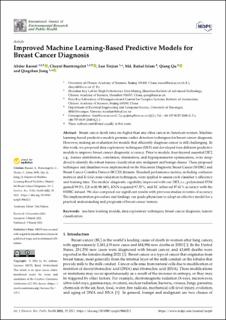| dc.contributor.author | Rasool, Abdur | |
| dc.contributor.author | Bunterngchit, Chayut | |
| dc.contributor.author | Tiejian, Luo | |
| dc.contributor.author | Islam, Md Ruhul | |
| dc.contributor.author | Qu, Qiang | |
| dc.contributor.author | Jiang, Qingshan | |
| dc.date.accessioned | 2022-06-14T09:10:05Z | |
| dc.date.available | 2022-06-14T09:10:05Z | |
| dc.date.created | 2022-05-31T19:27:25Z | |
| dc.date.issued | 2022-03 | |
| dc.identifier.citation | Rasool, A., Bunterngchit, C., Tiejian, L., Islam, Md. R., Qu, Q., & Jiang, Q. (2022). Improved Machine Learning-Based Predictive Models for Breast Cancer Diagnosis. International Journal of Environmental Research and Public Health, 19(6), 3211. | en_US |
| dc.identifier.issn | 1661-7827 | |
| dc.identifier.uri | https://hdl.handle.net/11250/2998644 | |
| dc.description.abstract | Breast cancer death rates are higher than any other cancer in American women. Machine learning-based predictive models promise earlier detection techniques for breast cancer diagnosis. However, making an evaluation for models that efficiently diagnose cancer is still challenging. In this work, we proposed data exploratory techniques (DET) and developed four different predictive models to improve breast cancer diagnostic accuracy. Prior to models, four-layered essential DET, e.g., feature distribution, correlation, elimination, and hyperparameter optimization, were deep-dived to identify the robust feature classification into malignant and benign classes. These proposed techniques and classifiers were implemented on the Wisconsin Diagnostic Breast Cancer (WDBC) and Breast Cancer Coimbra Dataset (BCCD) datasets. Standard performance metrics, including confusion matrices and K-fold cross-validation techniques, were applied to assess each classifier’s efficiency and training time. The models’ diagnostic capability improved with our DET, i.e., polynomial SVM gained 99.3%, LR with 98.06%, KNN acquired 97.35%, and EC achieved 97.61% accuracy with the WDBC dataset. We also compared our significant results with previous studies in terms of accuracy. The implementation procedure and findings can guide physicians to adopt an effective model for a practical understanding and prognosis of breast cancer tumors. | en_US |
| dc.language.iso | eng | en_US |
| dc.publisher | MDPI | en_US |
| dc.rights | Navngivelse 4.0 Internasjonal | * |
| dc.rights.uri | http://creativecommons.org/licenses/by/4.0/deed.no | * |
| dc.subject | brystkreft | en_US |
| dc.subject | maskinlæring | en_US |
| dc.subject | diagnostiseringsverktøy | en_US |
| dc.title | Improved Machine Learning-Based Predictive Models for Breast Cancer Diagnosis | en_US |
| dc.type | Peer reviewed | en_US |
| dc.type | Journal article | en_US |
| dc.description.version | publishedVersion | en_US |
| dc.rights.holder | © 2022 by the authors | en_US |
| dc.subject.nsi | VDP::Medisinske Fag: 700::Klinisk medisinske fag: 750::Onkologi: 762 | en_US |
| dc.source.pagenumber | 1-19 | en_US |
| dc.source.volume | 19 | en_US |
| dc.source.journal | International Journal of Environmental Research and Public Health (IJERPH) | en_US |
| dc.source.issue | 6 | en_US |
| dc.identifier.doi | 10.3390/ijerph19063211 | |
| dc.identifier.cristin | 2028601 | |
| dc.source.articlenumber | 3211 | en_US |
| cristin.ispublished | true | |
| cristin.fulltext | original | |
| cristin.qualitycode | 1 | |

